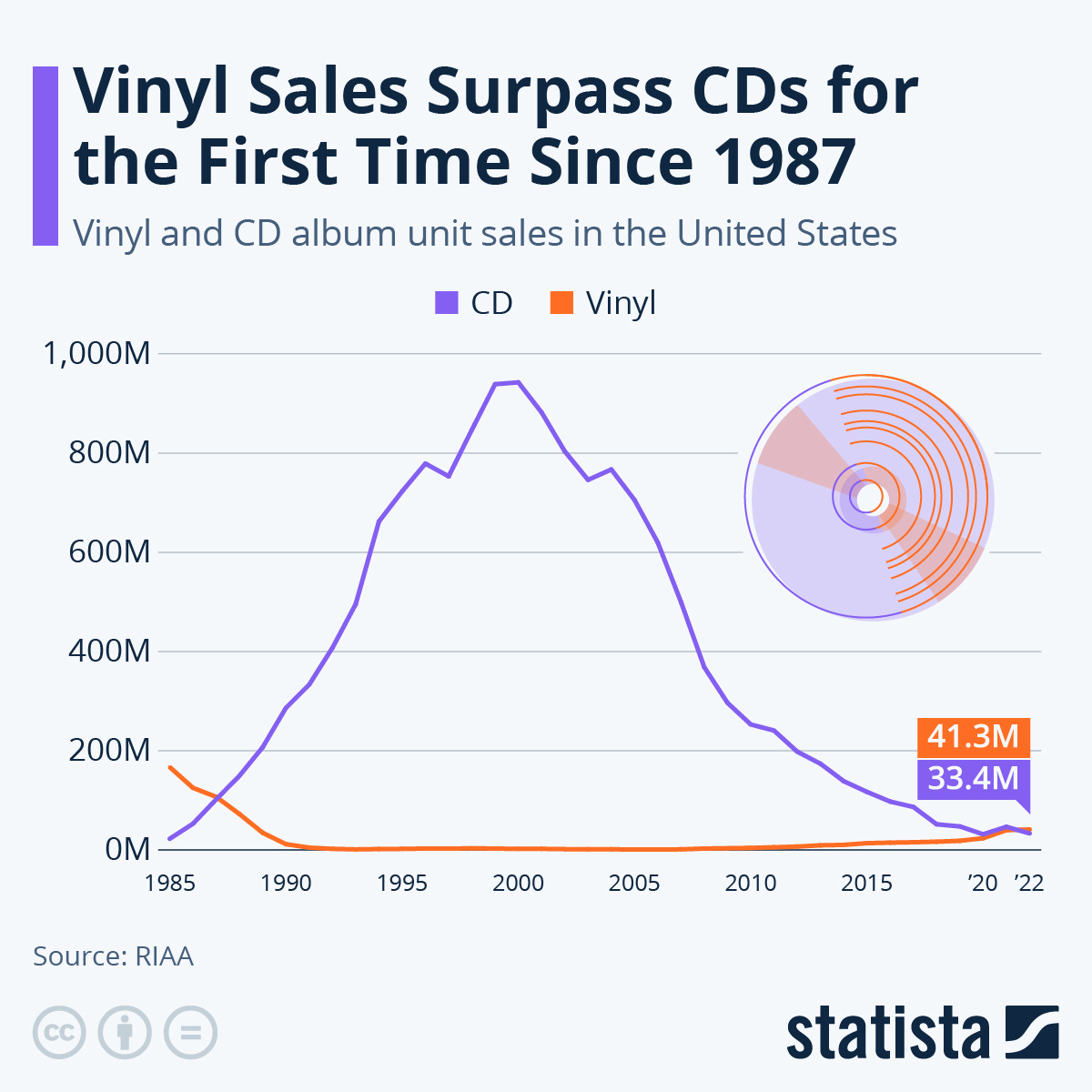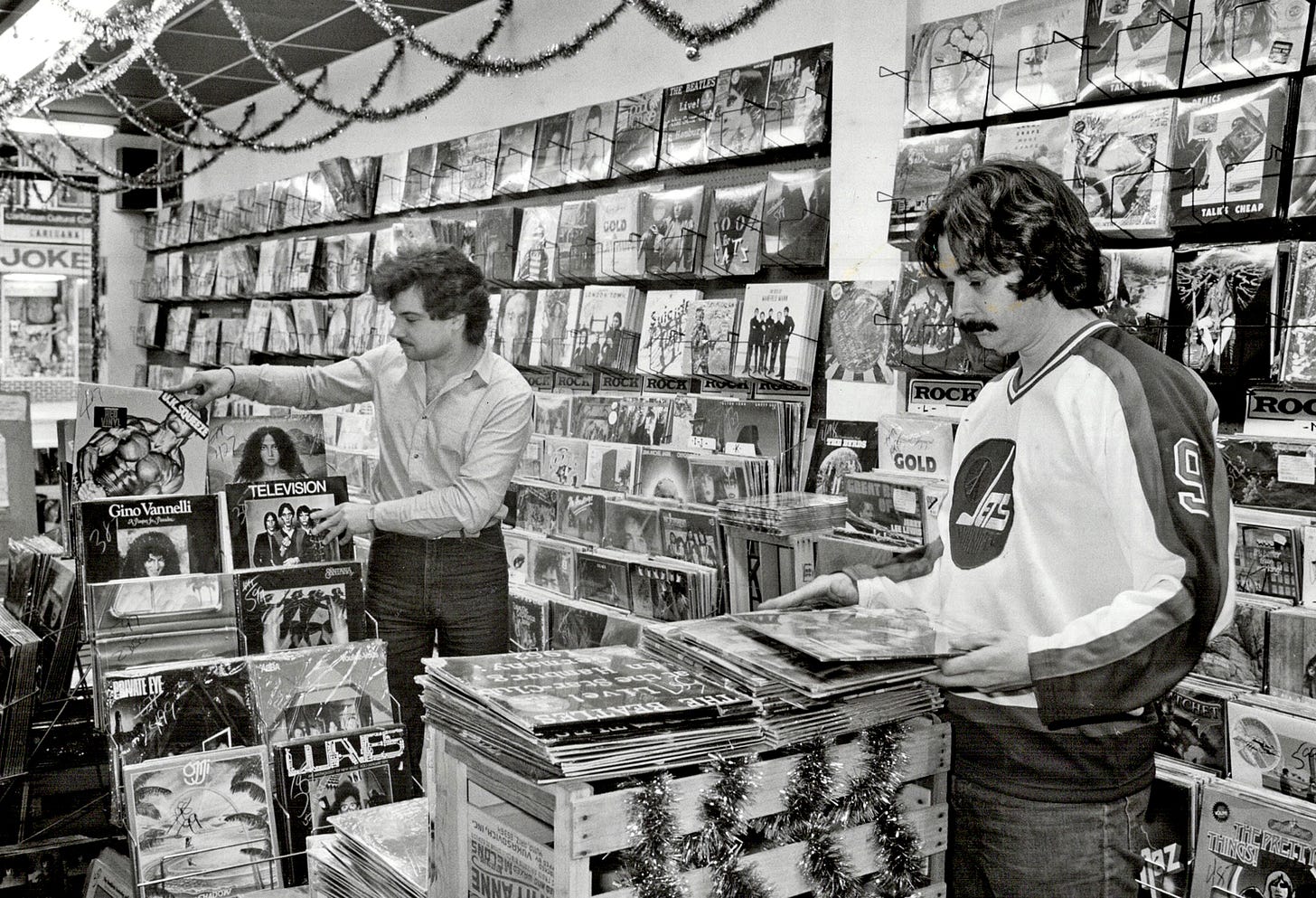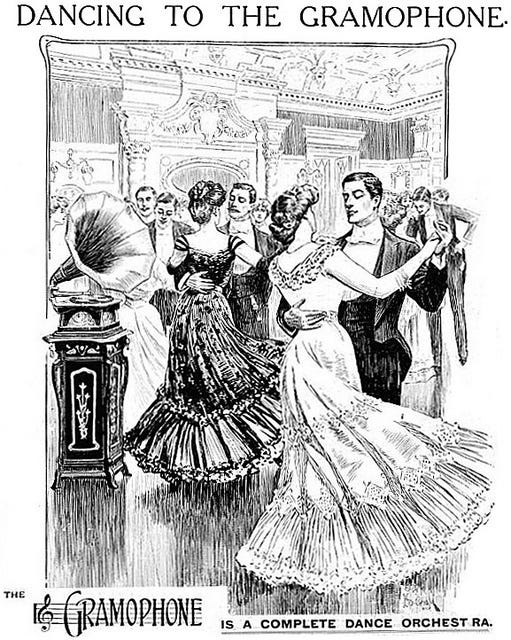I’ve been thinking about vinyl a lot lately. I’ve been thinking about it principally because my band’s new record came out a couple weeks ago and we spent a lot of time and hand wringing designing the vinyl edition. In fact, the sequencing of the record owes a lot to vinyl LP format, the way the side breaks informed the order of the songs. We waited breathlessly as our designer, Thunderwing, reported back from the printer’s about the quality of the cardstock, the toothiness of the mat paper. We had zoom conferences about the full color tip-in image that would sit inside an embossed frame, about the quality of the foil script spelling out the band name, how it would be embossed as well. I studied multi-page PDFs of colorways for the wax, deciding which would be the one for the webstore exclusive, which would be the one for this indie retailer or that indie retailer.
For a medium that has arguably been surpassed in cost-effectiveness, ease-of-use, and (let’s be honest) sound quality, the vinyl LP has stuck around like a stubborn houseguest, sitting there at the counter with their half-drunk glass of wine and making small talk.
I mean, I get it: it’s nice to have a physical thing, a physical object, one that you can hold and caress while you listen to the record — perhaps with a booklet you can read that isn’t the size of a postage stamp. Something you can prop up against your credenza with the album art on full display. I, too, have been seduced by the vinyl LP’s many charms.
Thing is, I’m not one of those people who’s nostalgic for the golden vinyl LP era, whatever that might be. The physical format that gets me all wistful is the cassette. That was my go-to format when I was discovering the music that made my life. But I was more than happy to adopt the CD when it came around. As physical objects go, the CD is at least an improvement on the cassette, with its papery, cheap J-card and its liner notes and lyric sheet — when they were included — reduced to such a size that required a magnifying glass to read; the album art, designed in a square format, cropped or stretched to fit the rectangular dimensions of the cheap, plastic tape case. We’ve only recently begun putting out Decemberists records on cassette, and it feels more like a novelty than anything else, a kind of response to vinyl fetishism. The vinyl LP, as physical totem, remains king.
How we returned to vinyl is still a bit of a mystery to me. Especially since I learned that only half of the people who are buying vinyl LPs actually own a record player. Of course, it’s none of my business what people choose to do with these things — display them on their wall, make potato chip bowls out of them, whatever — and I should only be thankful that people are actually paying money for my music. I am certainly thankful for that, what with the erosion of musicians’ incomes across the board. But it all seems so fragile, doesn’t it?
At a record store signing last weekend, I asked one of the employees if they had a certain RSD-exclusive LP that I’d wanted to get my hands on. It happened they did; it was a double LP affair and not available on streaming services. The price tag on the front of the jacket read $41.99. That struck me as pretty steep. Imagine my chagrin to get it home and discover that the whole package was pretty barebones: the gatefold sleeve (printed on your pretty standard cardstock) didn’t have a glued-down spine; there was no booklet included, just the vinyl. Now: I don’t pretend to know the financial calculus that went into determining the street price of that record and I’m not here to judge — but I worry that there will come a day when your average music consumer will decide that paying $42 for a glorified wall hanging will be a bridge too far. The vinyl LP industrial complex seems to me like a very shaky house of cards. One little slip and the whole thing is coming down.
And maybe it should come down. Already, we’re dealing with surmounting headaches over quality control on these things. Pressing plants can be notoriously dodgy; the new generation of mastering engineers can’t hold a candle to the people who mastered audio for vinyl in the seventies and eighties. Go and listen to your 180 gram, bubblegum-marbled vinyl edition of some record that came out in the last year or two, then compare that to that floppy, cellophane-thin LP of Emmylou Harris’s Pieces of the Sky that you grabbed from a bargain bin for five bucks. Scratches aside, I find that that “analog warmth” that people often ascribe to vinyl is mostly due to the engineers who recorded this music when it was the principal medium of the day. The entire mechanism around mastering for vinyl — not to mention the very delicate manufacture of it — was all but gone during the early part of the twenty first century and has only now been reconstituted from the leftover parts. It’s a system that was not built to handle this explosion of demand.

It makes me wonder about the contortions we go through to make the very best and most beautiful vinyl LP edition of our record — is it really worth it? Maybe it is, if someone is going to open it up, give it a brief gander, then thumbtack it to their wall. If that’s the case, then all that foil embossing and full color tip-in is really worth it. That’s what people want. On reflection, it’s what I want, too.
Like a lot of folks, I came to collecting vinyl in my twenties, when the medium was already way past its prime. There was a certain cache in owning vinyl of a contemporary band’s new album, when more mainstream acts had long ago eschewed pressing vinyl. It meant this band cared; it meant you were a real fan. And I did love indulging in the wide-screen album art, the poring-over of the liner notes and lyrics. And I sat down and listened intently when I played it, just letting that analog warmth cascade over me like some tropical breeze. Even though there were the occasional cracks and pops, the intermittent static from a charged felt platter mat, the warble of a slight warp in the vinyl, the wonky audio as it got closer to the center sticker — it just sounded better. Right?
Now: I’m not going to get into fisticuffs with the audiophiles among you, but I wonder sometimes — I just wonder — if there isn’t something in the fact that the arrival of modern-day vinyl fetishism just happened to coincide with the initial introduction of the original, lossy .mp3 format. Of course, compared to that pirated version of Radiohead’s Kid A that you spent an hour downloading from some dodgy filesharing site, the vinyl edition sure sounded like a million bucks.
But now, in the midst of a veritable arms race between streaming services about who can provide the most hi-fi, lossless, high bitrate audio of any given record — to an absurd extent — we’ve long put the artifact-cluttered, tinny mp3s of the early aughts behind us. I like to think of myself as someone who has an ear for good quality audio with decent equipment and I can’t tell the difference between Tidal’s supposedly superior files and, say Spotify’s basic-tier versions. At this point, IMHO, it’s less about audio quality and more about marketing. It’s about consumerism, it’s about FOMO. It’s about telling you that, oh, if you can’t tell the difference between this lossless version of Steely Dan’s Aja and whatever slightly-lower bitrate files you’ve been listening to, then you need to invest in better speakers, a better amplifier, a better set of headphones, man.
My radical take is that, no, vinyl LPs are not superior to the other mediums out there that are available at a moment’s notice from an application on the computer you carry around in your pocket. They’re quite inferior, actually. They have pops and crackles and they warp and you have to take them in and out of the sleeves to put them on and you have to turn them over when the needle finishes up the groove at the center of the disc.
But there’s something to that, isn’t there? There’s value in that. Maybe an LP pressed on vinyl is a steady reminder that music sings to us regardless of the bitrates, regardless of the data compression. And they make fantastic wall hangings.











I rarely play my vinyl versions (though I DO have a record player!). I just like having them because it’s a way for me to feel like I actually own that music, forever. Streaming licenses can be revoked/changed/cancelled. It’s in the TOS. No license BS will ever take away my LPs. 🙂
I bought a record player for the first time in my life a couple months back because I decided I wanted to purchase As It ever Was... on vinyl (and I couldn't fathom purchasing it and not actually playing the physical thing - who ARE those people?). Since, I've amassed a small collection, and the thing I've been most surprised about has been the feeling of being so much more INTENTIONAL with my listening at home.
I love a good, endless playlist of things The Algorithm thinks I'll certainly be into, but there is also some real joy in slowing down. Playing a board game and realizing I need to flip a record. Helps me stay in the present. It has been a nice change of pace, at least on occasion.